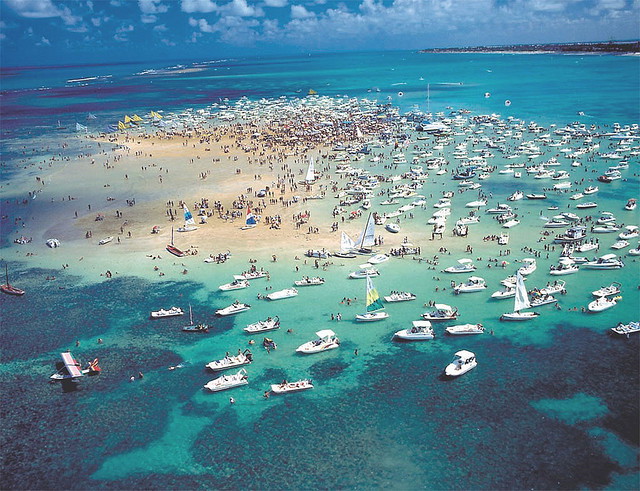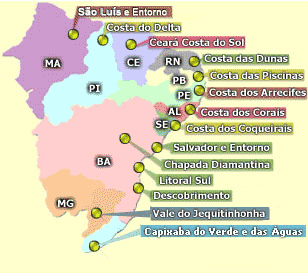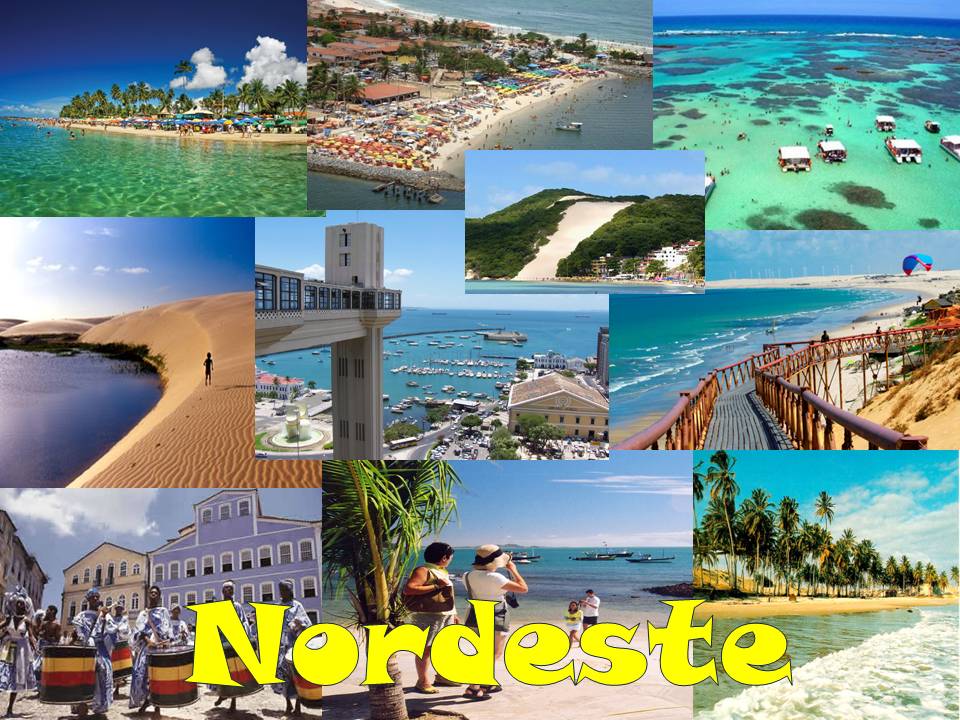The Destinations and Tourist Attractions of the Northeast Region of Brazil stand out for their expressive natural and cultural diversity, offering a unique combination of paradisiacal coastlines, exuberant landscapes and a valuable collection of historical heritage.

Northeastern Culture
Northeastern culture is one of the richest and most diverse in the country, the result of the confluence of Indigenous, African and European traditions.
This diversity manifests itself in folkloric expressions, gastronomy, music and popular festivals, which reflect not only the historical identity but also the socio-cultural resilience of local populations.
Cultural expressions and celebrations
Cultural expressions such as forró, frevo, maracatu and xaxado are recognised as national symbolic heritage, while traditional celebrations such as São João and the Olinda Carnival play a central role in the region’s tourism dynamics, attracting visitors from different parts of Brazil and abroad.

Natural wealth of the Northeast
In addition to the cultural aspect, the Northeast has established itself as one of the country’s main tourist centres due to its natural riches.
Among the most emblematic destinations and tourist attractions of the Northeast are the beaches of Fernando de Noronha, Port de Galinhas and Jericoacoara, as well as inland landscapes of great ecological value, such as the Chapada Diamantina, known for its geological formations and monumental waterfalls.
The northeastern hinterland, characterised by its semi-arid climate, is also of landscape and cultural importance, presenting unique elements of rural life and contributing to the understanding of the socio-environmental dynamics of the region.
Historical heritage
In terms of historical heritage, cities such as Olinda, São Luís and Salvador concentrate important examples of colonial architecture, sacred art and historic urbanism, making them fundamental centres for the study of Brazil’s historical formation.
The baroque churches, centuries-old mansions and cobbled streets are material witnesses to the colonial and imperial past, which, together with the hospitality of the people of the Northeast, create a tourist experience that combines memory, identity and belonging.
In this way, the Northeast of Brazil has consolidated itself as a territory of high tourist and cultural relevance, where the vectors of history, nature and popular culture intertwine in a complex and fascinating way.
Video – Main destinations in the North East

Principais Pontos Turísticos do Nordeste
Destinations and Tourist Attractions in the Northeast Region of Brazil
Most popular beaches
The most popular beaches in the region include various destinations and tourist attractions such as
- Arraial d’Ajuda and Morro de São Paulo in Bahia.
- Atalaia and Pirambu in Sergipe
- Pajuçara and Maragogi in Alagoas
- Porto de Galinhas and Itamaracá in Pernambuco
- Cabedelo and Tambaba in Paraíba
- Genipabu and Pipa in Rio Grande do Norte
- Jericoacoara and Canoa Quebrada in Ceará
- Coqueiro and Pedra do Sal in Piauí
- Curupu and Atins in Maranhão
Tambaba Beach, on the coast of Paraíba, was the first official naturist beach in the Northeast.
All the northeastern states have different folklore and traditions.
- Olinda, in Pernambuco, with traces of Dutch Brazil.
- São Luís, in Maranhão, with traces of Equinoctial France.
- São Cristóvão, in Sergipe, and its Praça de São Francisco, surrounded by imposing historical buildings.
- Salvador, in Bahia, with the remains of the political and administrative centre of colonial Brazil.
- Porto Seguro and Santa Cruz de Cabrália, also in Bahia, with the historical marks of the arrival of the squadrons that discovered Brazil..
These are some of the main historical and cultural attractions of the region, the first four of which are UNESCO World Heritage Sites.
The Barra district of Salvador(BA) is home to the Barra Lighthouse, one of the most famous postcards in Brazil and the most famous postcard in the Northeast.
The Barra Lighthouse in Salvador has a unique geographical location on the planet, where you can see both sunrise and sunset over the sea, as it occupies the tip of the peninsula on which the city stands.
Cultural attractions and festivals
The Culture of the Northeast is also a major attraction for tourists, with distinct folklore and traditions in each state.
Olinda, São Luís and the Pelourinho in Salvador are UNESCO World Heritage Sites.
Carnival in the Northeast is one of the biggest attractions, especially in Salvador and Recife.
The Salvador Carnival is the largest folk festival in the world, bringing together more than 2,700,000 revelers for six days of celebration. During this time, dozens of famous singers such as Ivete Sangalo, Daniela Mercury and Cláudia Leite perform in the trios elétricos.
The Recife Carnival is known for its cultural diversity, with giant puppets, frevo and maracatu, and for having the largest carnival block in the world, the Galo da Madrugada.
This carnival is considered the most democratic, as revelers don’t have to pay to play.
Ecotourism and nature
The Fernando de Noronha Archipelago is gaining national and international fame for the sightings of jumping dolphins.
Another outstanding site is the Lençóis Maranhenses National Park, a complex of dunes, rivers, lagoons and mangroves.
Bahia is home to the Costa do Sauípe, the largest tourist complex in Brazil, and the Abrolhos Archipelago, which offers excellent diving and attractions such as the humpback whale season, which begins in July.
Piauí is home to the Sete Cidades, Serra das Confusões and Serra da Capivara National Parks, known for their rock formations and cave paintings, as well as the Parnaíba Delta coastline.
Bahia’s coastline
Bahia has the largest percentage of the Brazilian coastline, with 932 kilometres, representing 12.4% of the total.
Bahia’s coastline is marked by Todos os Santos Bay, the largest bay in Brazil, with an area of 1,052 km² and a depth of up to 42 metres, with diving visibility between 10 and 20 metres.
Also noteworthy is Aratu Bay, an immense inlet that is home to the Port of Aratu, a shipyard, two of the ten most luxurious marinas in Latin America (Aratu Yacht Club and Aratu Marina) and the Aratu Naval Base..
Another point of interest is Camamu Bay, the third largest bay in Brazil, with historical and tourist sites such as Barra Grande, Camamu and Maraú.
Costa do Sauípe, on the coast of Bahia, is the largest tourist complex in Brazil and one of the largest in Latin America.
Gastronomy and Cuisine
The region’s gastronomy is one of its great attractions.
Bahian cuisine, the most famous in Brazil, is rich in spices, with dishes such as Acarajé, Abará, Caruru and Vatapá.
Paraíba cuisine is also well known, with specialities based on manioc and sugar cane, such as tapioca, rice pudding and sweet chorizo.
Conclusion
The Northeast of Brazil is a destination that offers a rich combination of culture, history and nature, attracting tourists from all over the world.
With its diverse festivals, natural beauty and unique cuisine, the region has established itself as one of the country’s main tourist centres, full of destinations and tourist attractions to delight everyone.
Publicações Relacionadas
The culture of Northeastern Brazil: how it originated, influenced and flourished
Natural Pools in Northeastern Brazil: A Guide
Tour of the Brazilian Northeast Coast: 10 Unforgettable Days
Route of the Discovery of Brazil: A Real Story
Extreme sports in the Northeast of Brazil: Destinations not to be missed
Influences and main dishes of northeastern cuisine
History of Baroque Architecture in the Northeast and Minas Gerais
The main tourist destinations in northeast Brazil
Best Beaches in the Northeast: A Complete Guide
Musical styles, rhythms, singers and composers of northeastern Brazil
Discover the nudist beaches of the Northeast and Brazil
Bahia Tourist Attractions You Cannot Miss
5 Chapadas of Brazil for Adventure Seekers
Best places to visit in the Northeast of Brazil
This post is also on:
![]() Português
Português ![]() English
English ![]() Deutsch
Deutsch ![]() Español
Español ![]() Français
Français



















